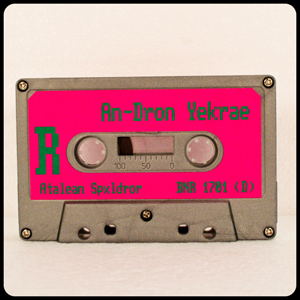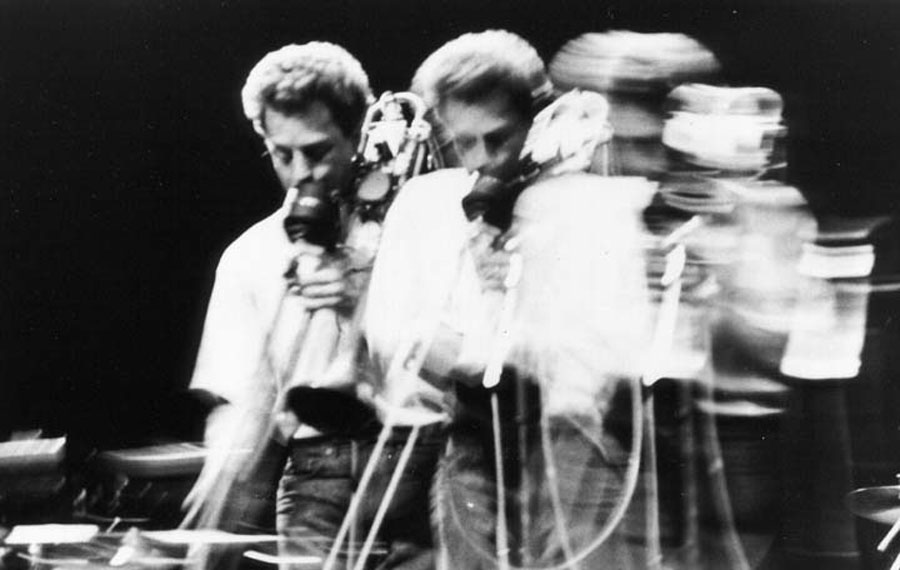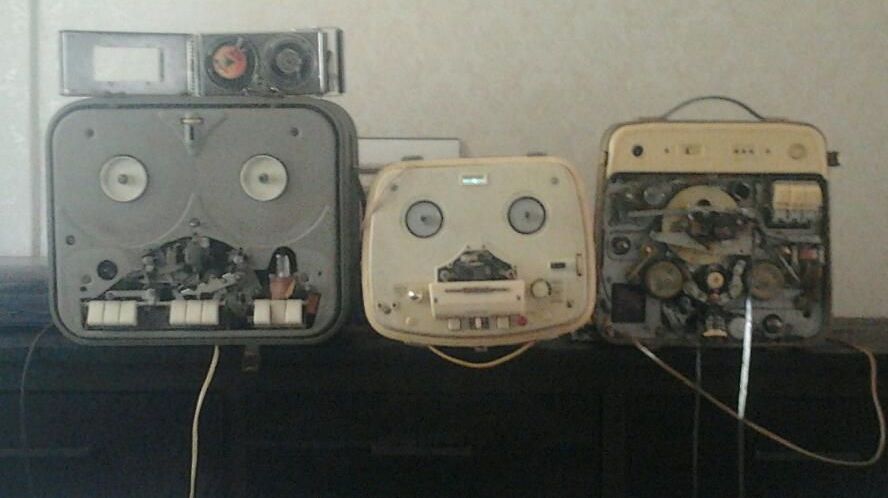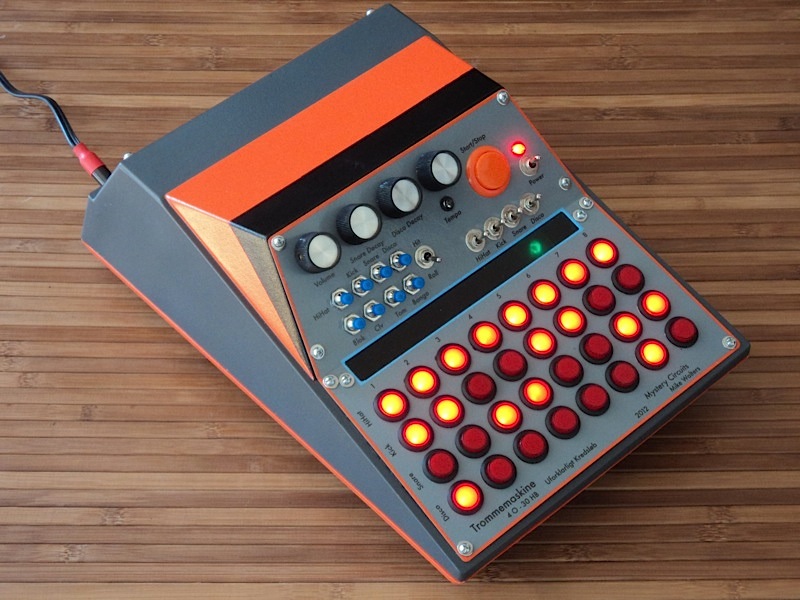9 tracks (9 minutes) of powerviolence/punk/grind. Tracked, edited, mixed, and mastered at Big Name.
9 tracks (9 minutes) of powerviolence/punk/grind. Tracked, edited, mixed, and mastered at Big Name.

The song “Pass Me the Yogurt Chips Before I Cremate Myself, Emilio” from my/Joel/Steve’s album Retail Monkey – ADD/Nihilism was just featured on the third edition of Mathcore Index’s compilation series. There’s lots of interesting music here to check out if you’re into this style.
Seattle’s Un came back to Big Name a few days ago to record drums for an upcoming release. It’s one 18 minute long track that will eventually be part of a split with a band from the UK. When we finished earlier than we expected, Monte (guitar/vocals and primary writer of Un’s music) suggested we use our remaining time to do a live video session. I thought that was a great idea. It’s always a pleasure to work with these guys.
An-Dron Yekrae – Atalean Spxldror
I am proud to present another new solo album. I think that its origins are worth discussing, as they’re pretty… odd.
One of the main principles that I follow while creating art is that the work must be allowed to flow freely, and that I should follow the art wherever it wants to go. Most of the time when I’m working on my own material, I try to actually get out of the way of the art, let whatever it is show itself, and then mold those raw impulses into a finished product. It feels like channeling something. This album was done that way, and it led me on a few twists and turns throughout its creation process.
Last year, melodies, chord progressions, and bass lines in the style of old jazz standards unexpectedly began popping into my head. Whenever this sort of thing happens, I make sure to capture and transcribe the ideas. After a few weeks of this process, I ended up with 14 complete pieces.
Originally I thought that they should be played in the style of a jazz combo, as would be expected for jazz standards. But I didn’t know how I was going to accomplish that. At this point, I can confidently say that I play drums and bass well, and piano decently… but playing jazz drums, bass, and piano is a different story. And I don’t play any traditional jazz lead instruments at all. My skills in that genre would need a lot of work before I could pull something like that off. So I puzzled over that impasse for a while, and the songs just sat while I worked on other things (like Retail Monkey – ADD/Nihilism and [syzygy] – [visitor] {which was “channeled” in a similar way to this album}).
When I have a project sitting, I can feel its weight in my mind. It takes up space and it makes me anxious. If I wait too long, the inspiration of the project can sometimes leave and never return. It wasn’t long before the incomplete project really began to bother me. I prefer to get things done and move along, but I knew something was not right about the way I was approaching it. So I couldn’t. After some time I realized that my original instrumental vision was definitely not how they were supposed to end up.
I realize how weird this all might sound, but at that point, the answer came to me. The project wanted to be a concept album: songs written by a character, an alien (An-Dron Yekrae) from another world (Atalea), who visited Earth and fell in love with two sounds: classic jazz and synthesizers. He got together some friends and recorded this album, melding those two interests. I don’t know where this idea came from, but it felt like the right answer, so I just shrugged and followed it. Immediately I rediscovered the flow state, and the entirety of the project was tracked within the week. After being stuck for quite a while, it turned back into a naturally flowing process. It was a blast to record all this stuff.
Yeah, like I said, it’s weird. But that’s what this project wanted to be. It was fun working with you, little alien jazz buddy.
Released on Big Name Records. BNR1701
Available on cassette via the Big Name Records Webstore or Bandcamp.
Cassettes were printed in the Big Name print shop.




Live @ Big Name sessions are finally a reality! I’d like to send a big thank you to Methczar for coming in yesterday and playing a few of their songs. I look forward to doing more of these in the future.
9 tracks (5 minutes) of punk/grind/powerviolence. Tracked, edited, mixed, and mastered at Big Name. This release was recorded on the studio’s Tascam 388 tape machine.
Holy North American Motor Highway – Self-Titled
holynorthamericanmotorhighway.bandcamp.com
2 tracks (36 minutes) of orchestral art-punk. Tracked, edited, mixed, and mastered at Big Name. This release was recorded on the studio’s Tascam 388 and TEAC A-1200U tape machines.
Tapes were duplicated in the print shop.
Here’s some amusing, interesting, insightful, or useful internet stuff I discovered in January of 2017.

This article focuses on three avant garde artists who pioneered the idea of using CDs and CD players as instruments in their own right. Each of the artists has their own distinct approach to the idea. It is a solidly-written, long-form article that provides good historical context and that also functions as a jumping off point for further discovery. Most of this month’s Internet Roundup entries were discovered as a chain, one leading to the next; that process began with this article.
Turning the audio transmission device into an art generation tool is a musical tradition that has a rich history in our culture. There are many ways in which artists have subverted the intended use of a playback medium. Most musicians are familiar with the use of reel-to-reel tape players in this way, either as delay units or loop players. The turntable also has ended up being used in a similar creative manner as both a sampler and as a lead instrument via the familiar technique of scratching. These sounds have become a well-known part of our musical milieu. But using the CD player in the same way has never reached the same ubiquity.
I really like this kind of outside-the-box thinking. While not directly addressing this topic, this article raises questions about the untapped sonic possibilities in our current mediums: MP3s and streaming services. Is there a way to utilize these devices and services as musical instruments in their own right? Are there undiscovered sounds lurking in the structure of digital music playback that are interesting and usable? I would bet that there are.

Nicolas Collins
nicolascollins.com
Nicolas Collins is featured in the above article from Soundfly due to his extensive usage of CD players as musical instruments. An interesting essay on his personal website about his CD-based works is referenced in the piece. Following that link exposed me to the rest of his body of work.
Collins is an experimental musician who is heavily influenced by John Cage and Alvin Lucier. Much of his work is electroacoustic, exploring the relationship of sound and space. He is very interested in creating works that question common, basic assumptions about music, and especially how those assumptions can be bent or broken. His work also often focuses on technology and how it can be built or modified to explore new musical possibilities.
As would be expected on a musician’s homepage, his site contains recordings of his pieces and his albums. Additionally, however, he makes available books and essays that he has written on practical and philosophical art topics. I appreciate when artists go into depth about the thought processes behind their works. Those discussions often bring about new, related ideas that can be explored. Beyond audio and writing, Collins also provides guides for making microphones and sound generators, as well as instructions on designing or bending circuits. Lastly, the site hosts many of his non-traditional scores, as well as custom software for performing some of these unique works. Collins has played with a lot of interesting ideas over the years and his catalog is inspiring in its creative breadth.

Joo Won Park is a composer and an assistant professor of music technology at Wayne State University. I found his work through his YouTube series 100 Strange Sounds. In this collection, Park generates samples from a variety of odd sources and processes them using a program called SuperCollider. This series makes use of many curious audio generation techniques. On his personal website this theme is explored further, branching into uncommon composition techniques as well.
Park’s work features non-traditional scores that often feature improvisational components. Some aspects of his compositions are generative. Many of his pieces feature a computer, often running digital sound manipulation algorithms that Park designed. One such composition, Control Click (dubbed a “piece for computer lab”) networks more than a dozen computers together. Each individual device performs a monophonic melody. All of them come together to create a generative audio-visual experience. As another example of something unique Park has done, in another performance he played a no-input mixer on an open-top bus as it drove through the city, interacting with the city as the artist and audience passed it by.
Park maintains a blog where he catalogs his works and also occasionally posts about software and fellow musicians that interest him.

Wouter Van Veldhoven
www.youtube.com/user/woutervanveldhoven
Wouter Van Veldhoven is a Dutch based experimental artist whose medium is difficult to define. His YouTube channel is a showcase of his studio experiments, most of which include him chaining together dozens of components to create automated compositions. His work crosses the boundaries between electronic and acoustic, installation piece and music composition, robotics and art.
For me personally, ambient music is usually a genre of little interest. These compositions, however, manage to be truly fascinating. Van Veldhoven uses secondhand materials driven by an analog Doepfer sequencer and many, many reel to reel decks to bring his studio to life. He has a real passion for experimenting with old tape recorders. His compositions utilize classic tape based techniques, like creating loops and delays, but then he often gets radically more creative with his patching. One example of a more advanced technique he uses is to rig up one single loop of tape through multiple reel to reel decks. Another is to use his Doepfer to automatically reverse the playback of a tape in real time, creating unique effects.
He is not afraid of using all sorts of odd things as automated musical devices. This includes televisions, radios, miscellaneous broken machines, sine wave generators, cassette decks, solenoids, and an array of modified self-playing instruments like the reed organ, zither, and toy piano. Robot-based music is often gimmicky, but Van Veldhoven’s compositions are genuinely haunting and beautiful.
Utilizing tape so heavily as part of his production process imparts a lo-fi, nostalgic quality onto the sound of the pieces. The dropouts along with the wow and flutter somehow abstractly communicate that Van Veldhoven’s living studio is a wise old soul.
He has albums available at woutervanveldhoven.bandcamp.com, and he maintains a blog at woutervanveldhoven.tumblr.com.

Mystery Circuits
mysterycircuits.com
Van Veldhoven’s monophonic cassette Mellotron made me wonder if anyone had used a bunch of cassette decks wired together to make a made a polyphonic Mellotron. A quick Google revealed that indeed, someone had.
That individual is Mike Walters of North Carolina. He’s a keyboardist and electronic instrument technician who designs his own creations during his free time. He then catalogs and writes about his instruments. On the site you can find oddities such as a drum machine where the snare is constructed of live radio waves, the aforementioned polyphonic cassette Mellotron, a repurposed and rehoused Italian auto-accompaniment machine, and much more. Quite a few of the devices on the site have audio and video samples, explanations of how the devices are played, and explanations of how they were built and how the circuits work.

Acreil
www.youtube.com/user/acreil
My discovery of Acreil’s work also came about through further exploration of Van Veldhoven’s ideas. I was fascinated by his Doepfer sequencer and wanted to see if such a thing existed within the digital realm. That was when I found the program known as Pure Data and, subsequently, the experimental algorithmic compositions of Acreil.
In a Pure Data algorithmic composition, the composer creates a program that consists of a series of rules, math equations, and logic gates. These are known as “objects” in Pure Data. The various objects interact with one another in ways determined by the composer, eventually leading to a device that generates musical notes. These notes can be played using oscillators (which generate simple waveforms or white noise) or MIDI (which allows you to connect to virtual instruments in a DAW like Pro Tools). These waveforms come together to create a piece of music. The composer can write the program so that the music is unique on every playthrough, or so that it is the same every time, depending on how they orient their objects.
Out of the catalog of Pure Data algorithmic compositions, Acreil’s work is noteworthy for three reasons. Firstly, most Pure Data musicians that I have encountered either make ambient songs or outright noise pieces. Acreil seems to be one of the few who creates actual rhythmic compositions with drums. Secondly, he has experimented quite a bit with microtonal composition. While many microtonal pieces sound very dissonant, his sound quite consonant. Lastly, while Pure Data can be connected to a DAW like Pro Tools to utilize virtual instruments, Acreil uses the sound generators in Pure Data exclusively. The sounds he achieves are very complex, so his setups for each individual instrument in his compositions must be quite advanced.
My piece Key West, composed in January, is directly inspired by Acreil’s work. It uses Pure Data, a microtonal tuning, and only sounds generated within Pure Data. I intend to write more using this composition method in the future.
Acriel’s work can be found on YouTube and his longer albums can be found on Bandcamp. The other focus of his YouTube channel is demonstrating the capabilities of individual keyboards by composing songs that only utilize patches from the keyboard in question. While they are much less experimental, these end up being enjoyable compositions in their own right.

All the Scales
allthescales.org
Being generous, we tend to use roughly twenty different scales in Western music. In reality, however, most the music we hear utilizes a paltry two of those, Major and Minor. That fact gets sadder: those two scales contain all the same intervals! The only difference is the degree on which the scale begins.
William Zeitler took the time to catalog every possible scale within the 12-tone system that repeats at the octave and that does not contain a jump of more than 3 semitones. He determined that there are 1,490 different scales that can be made from these parameters, each with its own set of modes. Not being content with merely pointing out the existence of this wealth of scales, he also created MIDI files for each one and uniquely named every single mode of every scale.
These scales can be utilized within the chord-scale system, or they can be used as a starting point for composition. Many microtonalists complain that the chromatic system is too limited, but this website shows that even within the limited 12-tone system there is a huge amount of musical territory left to explore. (Not that that should stop anyone from exploring microtonality!)

JLIAT: Silences
www.jliat.com/silence
If every full-length CD that could possibly exist was played from beginning to end in succession, the resulting audio would be longer than the amount of time from the beginning to the theorized end of the universe.
That totality is impossible to recreate in the physical universe. Within the realm of all-discs-that-could-exist, however, there is a realizable possibility: discs of silence. Due to the way that CDs read audio, there are 65,536 unique discs that would cause a player to render only silence, totaling out at 9 years of playback. The creator of this conceptual art piece, James Whitehead, put together and made available 65,536 files that render 10 seconds of each one of these unique silences (which comes out to over a week of non-sound).
The piece is reminiscent of John Cage’s groundbreaking 4’33”. The idea of quantifiably different silences is quite strange, as is the idea that all music that could ever exist is possible within a finite medium. As the artist states in the description of the download: “This poses the thought that any recording could be created by artistic talent, ingenuity, skill, sensitivity… or by brute force or accident.”

I first found this site in 2009, when it was still available at its original domain. A few years ago, I went looking for it again, only to discover that the domain had lapsed. This was greatly disappointing. After a number of attempts, a search this month on the Internet Archive finally yielded results.
As a child, I was diagnosed with inattentive ADD. The doctors who tested me concluded that it was the result of some mysterious brain defect. Unlike a “normal” person, I would be forever stuck with absent-mindedness, difficulty focusing, forgetfulness, the need to fidget, boredom, and difficult mood swings. They also diagnosed me with a significantly-lower-than-average cognitive processing speed, which is something that about 1/3 of people with ADD suffer. Despite the fact that the other testing metrics came out above average, the professionals placed the focus almost entirely on the negative results. They called it a “learning disability.”
I carried that around like a curse while growing up. Believing that I was born defective was not a healthy self-narrative and contributed (along with other things) to years of difficulty as a child and teenager. It was early 2009, at age 20, that things began to change. A good friend of mine and I were having a conversation in which I was complaining about the difficulty of being a slow ADD person in our overwhelmingly fast-paced world. This friend is a quick wit… so quick, in fact, that it would sometimes get him into trouble. Back then he had the tendency to speak before thoroughly thinking through the possible repercussions of what he was about to say. He pointed out that my introverted, calculated nature could easily be understood as a strength, as I never end up in those kinds of predicaments! He said he was jealous of my ability to always fully consider the impact of my words before speaking. My mind was blown. I had honestly never even considered that this “weakness” I had could be understood, or even utilized intentionally, as a strength.
Thus began a search of the internet for resources regarding this idea. Born to Explore was one of the first I found. Many of the ideas on the site have stuck with me to this day. There are a number of different profiles of types of people who fall under the ADD umbrella and ways to turn the normal negative interpretations of their symptoms into strengths. I believe this sort of reframing is something that can be done with many personality traits or other aspects of life that a person may be unhappy with. The Positive and Alternative Views and Positive Quotes pages were invaluable for my transformation from depressed youth into functional adult. This page also helped me realize the importance of seeking out a life which is the right fit for my mind and my own strengths and weaknesses. When I am pursuing the type of work that my mind excels at, my ADD symptoms are practically non-existent. I understand that the specifics of this story are probably of relatively limited interest to my audience, but if this archived page helps one person via this blog entry, then I will be happy.
9 tracks (32 minutes) of shoegaze/post-punk/dreampop. Tracked, edited, mixed, and mastered at Big Name.
6 tracks (47 minutes) of krautrock/post-punk/darkwave. Tracked, edited, mixed, and mastered at Big Name.